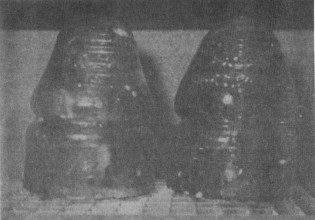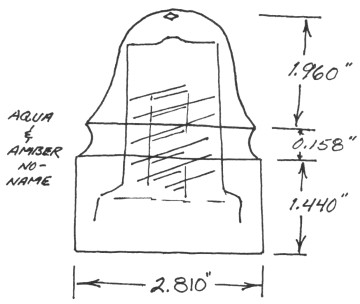Questions Answered by N. R. Woodward
Author of The Glass Insulator in America and originator of C.D. #'s (Consolidated Design Numbers)
Reprinted from "INSULATORS - Crown Jewels of the Wire", June 1976, page 4
Jim Woods, Collinsville, Illinois, writes:
Here is a photo showing two early Hemingray insulators. The one on the right
is a CD 133.4 with Patent Dec. 19,1871 on the front and 3 on the back dome. The
one on the left, I assume, is a CD 134, with Patent Dec. 19,1871 in very large
letters. The unusual part is a large 3 on the back dome.

I've never seen this
variation of the 3 before and wonder if anyone else has found any. By the way,
this specimen was dug up and found to be lining a long forgotten garden. With it
were CD 126's, 126.3's, 127's 133.4's, and a number of CD 133 1865, 1870, 1870
Brookfields. Last August I purchased a CD 121 W.G.M. Co. in a light shade of
S.C.A., but very milky, so deep it can't be seen through. Have any of these been
reported?
- - - - - - - - -
In reply to Jim Woods: The two Hemingray No. 3 are CD #133 and CD #133.4.
They are probably about equally common, although most of the CD #133 Hemingray
No. 3 that I have seen have a letter (A, B, C) below the 3.
The W.G.M. Co. insulators occasionally show up with the purple "milk
glass". Often they have milky swirls; but one as opaque as yours is quite
rare.
From Ed Smith, Seminole, Florida: I have two beautiful amber Hemingray 45.
One is so dark you can barely see through it. The other is dark, but light
passes through it easily. My question is, "Are there other amber Hemingrays
known?" I have shown these insulators to several other collectors here in
Florida. Most collectors believe them authentic, but some say they were treated
with cobalt to turn them amber. What do you think? Thank you for your opinion.
- - - - - - - - -
In reply to Ed Smith: It is not possible to say positively that no amber
Hemingray 45's were made, but I have never known of any other than those
artificially created through radiation. It is also true that, in come cases at
least, the irradiated amber fades with passing of time. Since those who make
these things are not proud of their work and do not identify themselves among
collectors generally, little is known of their methods or of which items have
been so treated.
To digress a bit from the intent of your inquiry, Hemingray 45 was made for
nearly 30 years (1938 to 1967, approximately). Had you given the exact markings
and number of dots on your insulators, we could have identified them as to date
of manufacture. While this would not give us a positive answer on the amber
color, it is always meaningful to identify as closely as possible the age of any
insulator when we are discussing it for any reason. Note the next item.
Mike S. Bielinski, Arlington, Texas writes: I am eleven years old and have
been collecting since last August. If all collectors were as helpful and nice to
young beginners as Mr. Waldrop of Lubbock, Texas, has been to me, there really
would be a lot more collectors.
I have a Hemingray 42 which fits CD 154, line 1715, except it does not have
the "M R" before Hemingray. I do not find it listed elsewhere. It is
clear.
Front: HEMINGRAY - 42
Back: MADE IN U.S.A.
8::::
9B
- - - - - - - - -
In reply to Mike Bielinski: Your Hemingray 42 is really quite a common one.
Since so few persons take an interest in details of the various mold sets of the
common insulators, unfortunately those making price lists often do not
distinguish them except for the occasional variation that is impressive enough
to attract attention, like the MR. Your 42 was made in the "short"
molds which were first used early in World War II. Yours is from Mold 9B and was
made in 1947, the last year those molds were used. In 1948 a new mold set was
made up which has a slightly different shape. The "MR" insulator is of
the larger size, made during the 1920's and 1930's, and would be about 1/4 inch
taller than your 9B. The MR is mold 36A, made in 1936. The letters MR are
actually above "HEMINGRAY", in much larger letters.
From Milo E. Holland, Washington, D.C.: I have been sitting here looking at
my insulators (as usual), and I noticed something about one of my CD 106
Hemingrays: Front, HEMINGRAY/ No 9, (B) PATENT/ MAY 2 1893. The top of it is
2-3/8", as opposed to most of the others (2-1/8"); the wire groove
is also 3/16" wider; the inside of the dome is flat, as opposed to dome
shaped; and there is a small circle under the dome, the same as all my
"stars". Because of the inner dome construction, do you think that
there is any connection between Hemingray and the mfg. of the "stars"?
I would appreciate greatly hearing your opinion.
- - - - - - - - -
In reply to Milo E. Holland: Your Hemingray No. 9 is not unusual for that
period. It's one of the earlier ones, and many of them did have the flat top
pinhole. A great many methods were used in the machining of the mandrels; and in
those early years probably not much attention was paid to them. It was later
decided that it was important that the top of the pinhole not bear directly
against the top of the pin while the insulator was in service. This was thought
to be the cause of the glass cracking at times. For many years nearly all
insulators had the concave area in the pinhole top to prevent this. Yet, some
much newer insulators do not; so perhaps it was decided that feature was not so
important after all.

From John de Sousa, Bloomfield, Connecticut: Been interested in finding more
about this no name insulator (sketch above). This is the third I've ever seen,
and now I own it. Two were aqua and one dark amber, very similar to a CD 133
American. Threads start low in the pinhole, with a large glass drip in the
pinhole top. The threads look as if they were a two segment thread and filled
in. The crown top is embossed with a tiny diamond. Mold lines go from the bottom
of the insulator to the top of the wire groove. As far as I can find out, these
are probably from the Boston area.
- - - - - - - - -
In reply to John de Sousa: Thank you for a detailed description of a most
interesting insulator! Sorry, but I can't offer any facts about this whatever,
except to note that various details do look very much like early Boston glass;
so your information is probably accurate in regard to its source.
| 